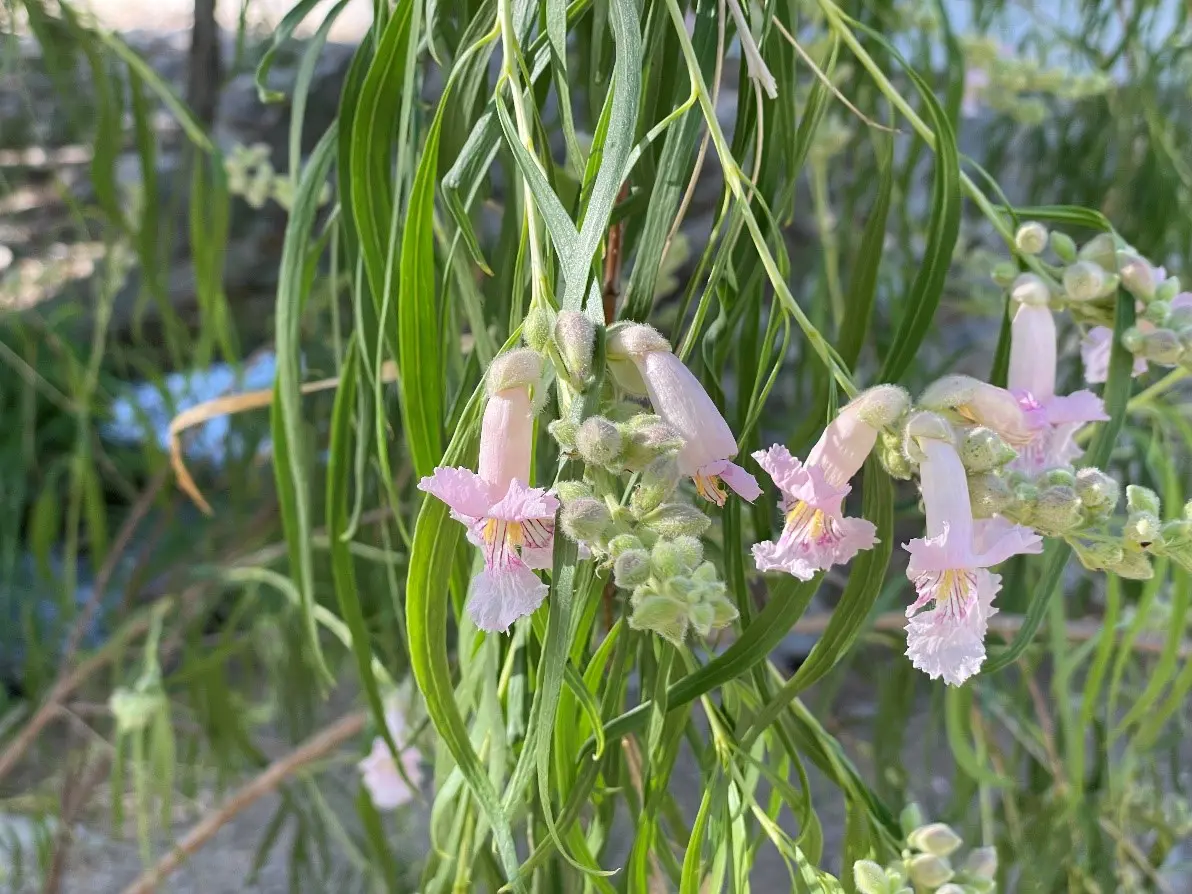The Desert Willow

WHAT A SHOW! DO THESE FLOWERS REMIND YOU OF ORCHIDS?
The desert willow tree (Chilopsis linearis) is not large in size, but it makes a big impact on the landscape, wildlife, and visitors at Clark County Wetlands Park. Despite their common name, these trees are not willows at all, but members of the Bignonia Family (Bignoniaceae).They grow well in most soils, and are found in desert washes, floodplains, and riparian areas across the southwestern United States.
Desert willow is well adapted to the extremes of desert life. It can send its roots fifty feet or more into the ground in search of water. Its leaves have a waxy coating that helps prevent moisture loss, and in severe droughts it can drop all of its leaves and become dormant until conditions improve. The trees have been known to die back almost to the trunk in very bad drought conditions, then produce new shoots almost immediately after a rain or a good flash flood down the wash where they are growing!
The trees produce long, slender seed pods that split open to release wind-distributed seeds. Seedlings may establish near parent plants and form thickets in drainages and along washes or ride the breeze to a new location and establish themselves there. Their deep roots make them important agents in erosion control, holding soils in place.
Desert willow trees range in size from 6-30 feet tall with canopies 8-20 feet across. Their bright green leaves are long and slender, producing shady resting places for wildlife and Park visitors that really feel as cool as they look! Extremely fragrant pale pink to purple, orchid-like flowers bloom abundantly from April to July, and even into the fall when conditions are right.
Beautiful? Absolutely! The desert willow has become very popular as a landscape tree, and several nursery varieties (called “cultivars”) with hot pink to burgundy flowers are available for purchase. In the landscape, the trees need only one watering every month or two in dry weather to maintain their attractive appearance. An additional “plus” for shade and color in the yard is the absence of thorns!
Useful? Yes! Native Americans dried desert willow flowers to make tea. Its powdered bark and leaves have been used for first aid for scratches and rock scrapes. The hard wood was used to make hunting bows, and later as fence posts on ranches and farms.
Desert willow is pollinated mainly by large black carpenter bees, but other bees also find it irresistible and make delightful honey from the flowers. It is attractive to birds as a nesting site. Hummingbirds visit for nectar, and the seeds are a popular food for seed-eating birds. White-winged moth larvae feed on its leaves, and the moths’ pupa cases (about 1” long) can often be seen on branches in late spring and early summer.
During a recent “Night Walk” for Park volunteers, the desert willow at the foot of the Nature Center ramp near Vern’s Pond gave participants quite a surprise. We started the walk at sunset, taking the ramp down to start our walk, stopping to look at the tree. The tree was in bloom, and the blooms were literally alive with large sphinx moths! There must have been hundreds swarming around the tree and sipping nectar from the flowers. We could actually hear the rustling of all those wings! I have never seen so many moths in one place, before or since!
So, enjoy the desert willow cultivars blooming in the Nature Center parking lot this summer on your way to the building. And don’t forget to stop at the foot of the ramp near Vern’s Pond and cool off in the shade of our “photo model.” Boulders are available where you can sit in the shade and enjoy the sound of the little stream flowing into the pond. While you rest, keep an eye on all the insect and bird “comings and goings” around that small tree!
-By Chris Leavitt
Please enjoy these YouTube videos!
Arboretum Feature/Desert Willow (CSUF Extension) 2:37
Native Plants and Animals-Desert Willow 4:55
Lesser Goldfinch feeding on Desert Willow Tree 1:32
A special note: Friends does not endorse or have any affiliation with advertising displayed on any of these videos.
